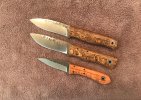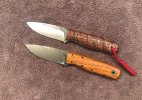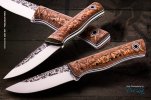- Joined
- Jan 1, 2009
- Messages
- 3,427
I was going to post up a question asking about Quarter Sawn Oak. Asking about its properties. And basically why It was used and whether I would like it.
But then it hit me.
I'm not some lazy internet slug. I am capable of doing my own thinking, and my own research. So I did some digging. It appears quarter sawn wood. Has many benefits. Workability, exceptionally pretty, and dimensionally stable.
Who Knew?
http://www.hardwooddistributors.org/blog/postings/what-is-quarter-sawn-wood/
Excerpt;
WHY USE QUARTERSAWN?
Quarter sawn wood has an amazing straight grain pattern that lends itself to design. Often used for cabinetry, flooring, high-end custom crafts and furniture, it is the traditional wood used in making mission style furniture. Dramatic flecking is also present in red oak and white oak. Other wood species that are sought after in quarter sawn are walnut, maple and cherry.
In addition to the desirable grain pattern this type of wood is some of the most dimensionally stable, making it ideal to work with. Quarter sawn lumber exhibits almost no twisting, warping and cupping. It is more resistant to moisture penetration and less prone to surface checking and raised grain.
More dimensionally stable and beautiful to look at? “Is there a downside to it?,” you ask. Well, yes. Because the manufacturing process results in a lower yield and is more labor intensive to produce quarter sawn lumber, the cost is higher. There is also a more limited supply because a smaller number of sawmills produce it.
But then it hit me.
I'm not some lazy internet slug. I am capable of doing my own thinking, and my own research. So I did some digging. It appears quarter sawn wood. Has many benefits. Workability, exceptionally pretty, and dimensionally stable.
Who Knew?
http://www.hardwooddistributors.org/blog/postings/what-is-quarter-sawn-wood/
Excerpt;
WHY USE QUARTERSAWN?
Quarter sawn wood has an amazing straight grain pattern that lends itself to design. Often used for cabinetry, flooring, high-end custom crafts and furniture, it is the traditional wood used in making mission style furniture. Dramatic flecking is also present in red oak and white oak. Other wood species that are sought after in quarter sawn are walnut, maple and cherry.
In addition to the desirable grain pattern this type of wood is some of the most dimensionally stable, making it ideal to work with. Quarter sawn lumber exhibits almost no twisting, warping and cupping. It is more resistant to moisture penetration and less prone to surface checking and raised grain.
More dimensionally stable and beautiful to look at? “Is there a downside to it?,” you ask. Well, yes. Because the manufacturing process results in a lower yield and is more labor intensive to produce quarter sawn lumber, the cost is higher. There is also a more limited supply because a smaller number of sawmills produce it.
Last edited:

 I think this is a perfect opportunity to start showing off some quartersawn oak Knives. I’ll be posting mine soon
I think this is a perfect opportunity to start showing off some quartersawn oak Knives. I’ll be posting mine soon


